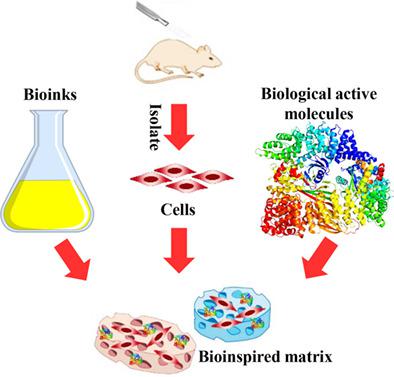当前位置:
X-MOL 学术
›
J. Appl. Polym. Sci.
›
论文详情
Our official English website, www.x-mol.net, welcomes your feedback! (Note: you will need to create a separate account there.)
Bioprinting a cell‐laden matrix for bone regeneration: A focused review
Journal of Applied Polymer Science ( IF 3 ) Pub Date : 2020-09-17 , DOI: 10.1002/app.49888 Farnaz Ghorbani 1 , Dejian Li 1 , Zeyuan Zhong 1 , Melika Sahranavard 2 , Zhi Qian 1 , Shuo Ni 1 , Zhenhua Zhang 1, 3 , Ali Zamanian 2 , Baoqing Yu 1
Journal of Applied Polymer Science ( IF 3 ) Pub Date : 2020-09-17 , DOI: 10.1002/app.49888 Farnaz Ghorbani 1 , Dejian Li 1 , Zeyuan Zhong 1 , Melika Sahranavard 2 , Zhi Qian 1 , Shuo Ni 1 , Zhenhua Zhang 1, 3 , Ali Zamanian 2 , Baoqing Yu 1
Affiliation

|
Although many efforts have been made to regenerate the bone lesions, existing challenges can be mitigated through the development of tissue engineering scaffolds. However, the weak control on the microstructure of constructs, limitation in preparation of patient‐specific and multilayered scaffolds, restriction in the fabrication of cell‐laden matrixes, and challenges in preserving the drug/growth factors' efficacy in conventional methods have led to the development of bioprinting technology for regeneration of bone defects. So in this review, conventional 3D printers are classified, then the priority of the different types of bioprinting technologies for the preparation of the cell/growth factor‐laden matrixes are focused. Besides, the bio‐ink compositions, including polymeric/hybrid hydrogels and cell‐based bio‐inks are classified according to fundamental and recent studies. Herein, different effective parameters, such as viscosity, rheological properties, cross‐linking methods, biodegradation biocompatibility, are considered. Finally, different types of cells and growth factors that can encapsulate in the bio‐inks to promote bone repair are discussed, and both in vitro and in vivo achievement are considered. This review provides current and future perspectives of cell‐laden bioprinting technologies. The restrictions and challenges are identified, and proper strategies for the development of cell‐laden matrixes and high‐performance printable bio‐inks are proposed.
中文翻译:

生物印花细胞负载基质以进行骨再生:重点综述
尽管已经做出许多努力来再生骨损伤,但是可以通过组织工程支架的开发来减轻现有的挑战。然而,对构建体微观结构的控制不力,制备患者特异性和多层支架的局限性,制备载有细胞的基质的局限性以及在传统方法中保持药物/生长因子功效的挑战导致了药物治疗。骨缺损再生生物打印技术的发展。因此,在本综述中,对常规3D打印机进行了分类,然后重点介绍了制备细胞/生长因子负载矩阵的不同类型生物打印技术的优先级。此外,生物墨水成分 包括聚合物/混合水凝胶和基于细胞的生物墨水已根据基础研究和最新研究进行了分类。在此,考虑了不同的有效参数,例如粘度,流变性,交联方法,生物降解生物相容性。最后,讨论了可以封装在生物墨水中以促进骨修复的不同类型的细胞和生长因子,并考虑了体外和体内的成就。这篇综述提供了当前和将来有关充满细胞的生物打印技术的观点。明确了限制和挑战,并提出了开发富含细胞基质和高性能可印刷生物墨水的适当策略。考虑生物降解生物相容性。最后,讨论了可以封装在生物墨水中以促进骨修复的不同类型的细胞和生长因子,并考虑了体外和体内的成就。这篇综述提供了当前和将来有关充满细胞的生物打印技术的观点。确定了限制和挑战,并提出了开发富含细胞基质和高性能可印刷生物墨水的适当策略。考虑生物降解生物相容性。最后,讨论了可以封装在生物墨水中以促进骨修复的不同类型的细胞和生长因子,并考虑了体外和体内的成就。这篇综述提供了当前和将来有关充满细胞的生物打印技术的观点。确定了限制和挑战,并提出了开发富含细胞基质和高性能可印刷生物墨水的适当策略。
更新日期:2020-11-17
中文翻译:

生物印花细胞负载基质以进行骨再生:重点综述
尽管已经做出许多努力来再生骨损伤,但是可以通过组织工程支架的开发来减轻现有的挑战。然而,对构建体微观结构的控制不力,制备患者特异性和多层支架的局限性,制备载有细胞的基质的局限性以及在传统方法中保持药物/生长因子功效的挑战导致了药物治疗。骨缺损再生生物打印技术的发展。因此,在本综述中,对常规3D打印机进行了分类,然后重点介绍了制备细胞/生长因子负载矩阵的不同类型生物打印技术的优先级。此外,生物墨水成分 包括聚合物/混合水凝胶和基于细胞的生物墨水已根据基础研究和最新研究进行了分类。在此,考虑了不同的有效参数,例如粘度,流变性,交联方法,生物降解生物相容性。最后,讨论了可以封装在生物墨水中以促进骨修复的不同类型的细胞和生长因子,并考虑了体外和体内的成就。这篇综述提供了当前和将来有关充满细胞的生物打印技术的观点。明确了限制和挑战,并提出了开发富含细胞基质和高性能可印刷生物墨水的适当策略。考虑生物降解生物相容性。最后,讨论了可以封装在生物墨水中以促进骨修复的不同类型的细胞和生长因子,并考虑了体外和体内的成就。这篇综述提供了当前和将来有关充满细胞的生物打印技术的观点。确定了限制和挑战,并提出了开发富含细胞基质和高性能可印刷生物墨水的适当策略。考虑生物降解生物相容性。最后,讨论了可以封装在生物墨水中以促进骨修复的不同类型的细胞和生长因子,并考虑了体外和体内的成就。这篇综述提供了当前和将来有关充满细胞的生物打印技术的观点。确定了限制和挑战,并提出了开发富含细胞基质和高性能可印刷生物墨水的适当策略。


























 京公网安备 11010802027423号
京公网安备 11010802027423号